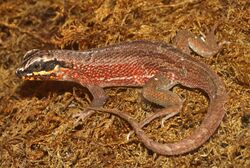Biology:Iguanomorpha
| Iguanomorpha | |
|---|---|

| |
| Leiocephalus personatus, a species of iguanian | |
| Scientific classification | |
| Domain: | Eukaryota |
| Kingdom: | Animalia |
| Phylum: | Chordata |
| Class: | Reptilia |
| Order: | Squamata |
| Clade: | Toxicofera |
| Clade: | Iguanomorpha Sukhanov, 1961 |
| Suborder: | Iguania Cope, 1864 |
| Subgroups | |
Iguania is an infraorder of squamate reptiles that includes iguanas, chameleons, agamids, and New World lizards like anoles and phrynosomatids. Using morphological features as a guide to evolutionary relationships, the Iguania are believed to form the sister group to the remainder of the Squamata,[1] which comprise nearly 11,000 named species, roughly 2000 of which are iguanians. However, molecular information has placed Iguania well within the Squamata as sister taxa to the Anguimorpha and closely related to snakes.[2] The order has been under debate and revisions after being classified by Charles Lewis Camp in 1923 due to difficulties finding adequate synapomorphic morphological characteristics.[3] Most Iguanias are arboreal but there are several terrestrial groups. They usually have primitive fleshy, non-prehensile tongues, although the tongue is highly modified in chameleons.[citation needed] Today they are scattered occurring in Madagascar, the Fiji and Friendly Islands and Western Hemisphere.[4]
Classification
The Iguania currently include these extant families:[5][6]
- Clade Acrodonta
- Family Agamidae – agamid lizards, Old World arboreal lizards
- Family Chamaeleonidae – chameleons
- Clade Pleurodonta – American arboreal lizards, chuckwallas, iguanas
- Family Leiocephalidae
- Genus Leiocephalus: curly-tailed lizards
- Family Corytophanidae – helmet lizards
- Family Crotaphytidae – collared lizards, leopard lizards
- Family Hoplocercidae – dwarf and spinytail iguanas
- Family Iguanidae – marine, Fijian, Galapagos land, spinytail, rock, desert, green, and chuckwalla iguanas
- Family Tropiduridae – tropidurine lizards
- subclade of Tropiduridae Tropidurini – neotropical ground lizards
- Family Dactyloidae – anoles
- Family Polychrotidae
- subclade of Polychrotidae Polychrus
- Family Phrynosomatidae – North American spiny lizards
- Family Liolaemidae – South American swifts
- Family Opluridae – Malagasy iguanas
- Family Leiosauridae – leiosaurs
- subclade of Leiosaurini Leiosaurae
- subclade of Leiosaurini Anisolepae
- Family Leiocephalidae
Phylogeny
Below is a cladogram from the phylogenetic analysis of Daza et al. (2012) (a morphological analysis), showing the interrelationships of extinct and living iguanians:[3]
| Iguanomorpha |
| ||||||||||||||||||||||||||||||||||||||||||||||||||||||||||||||||||||||||||||||||||||||||||||||||||||||||||||||||||||||||||||||||||||||||||||||||||||||||||||||||||||||||||||||||||||||||||||||||||||||||||||||||||||||||||||||||||||||||||||||||||||||||||||||||||||||||||||||||||||||||||||||||||||||||||||||||||||||||||||||||||||||||||||||||
The extinct Arretosauridae (Paleogene iguanians from Central Asia) are alternatively classified in either the Acrodonta with other Old World iguanians, or in Pleurodonta as a sister group to the Crotaphytidae.[7][8]
Conservation status
As of 2020 The IUCN Red List of endangered species lists 63.3% of the species as Least concern, 6.7% Near Threatened, 8.2 vulnerable, 9.1% endangered, 3.1% critically endangered, 0.3 extinct and 9.2% data deficient. The major threats include agriculture, residential and commercial development.[9]
References
- ↑ Gauthier, Jacques A.; Kearney, Maureen; Maisano, Jessica Anderson; Rieppel, Olivier; Behlke, Adam D. B. (April 2012). "Assembling the Squamate Tree of Life: Perspectives from the Phenotype and the Fossil Record". Bulletin of the Peabody Museum of Natural History 53 (1): 3–308. doi:10.3374/014.053.0101.
- ↑ Vidal, N.; Hedges, S. B. (2005). "The phylogeny of squamate reptiles (lizards, snakes, and amphisbaenians) inferred from nine nuclear protein-coding genes". Comptes Rendus Biologies 328 (10–11): 1000–1008. doi:10.1016/j.crvi.2005.10.001. PMID 16286089. https://comptes-rendus.academie-sciences.fr/biologies/articles/10.1016/j.crvi.2005.10.001/.
- ↑ 3.0 3.1 Daza, Juan D.; Abdala, Virginia; Arias, J. Salvador; García-López, Daniel; Ortiz, Pablo (2012). "Cladistic Analysis of Iguania and a Fossil Lizard from the Late Pliocene of Northwestern Argentina". Journal of Herpetology 46 (1): 104–119. doi:10.1670/10-112.
- ↑ Moody, Scott M. (June 1985). "Charles L. Camp and His 1923 Classification of Lizards: An Early Cladist?". Systematic Zoology 34 (2): 216–222. doi:10.2307/2413329.
- ↑ Wiens, John J.; Hutter, Carl R.; Mulcahy, Daniel G.; Noonan, Brice P.; Townsend, Ted M.; Sites, Jack W.; Reeder, Tod W. (23 December 2012). "Resolving the phylogeny of lizards and snakes (Squamata) with extensive sampling of genes and species". Biology Letters 8 (6): 1043–1046. doi:10.1098/rsbl.2012.0703. PMID 22993238.
- ↑ Schulte, James A.; Valladares, John Pablo; Larson, Allan (2003). "Phylogenetic Relationships within Iguanidae Inferred Using Molecular and Morphological Data and a Phylogenetic Taxonomy of Iguanian Lizards". Herpetologica 59 (3): 399–419. doi:10.1655/02-48.
- ↑ Alifanov, V. R. (2012-07-01). "Lizards of the family Arretosauridae Gilmore, 1943 (Iguanomorpha, Iguania) from the Paleogene of Mongolia" (in en). Paleontological Journal 46 (4): 412–420. doi:10.1134/S0031030112040028. ISSN 1555-6174. Bibcode: 2012PalJ...46..412A. https://doi.org/10.1134/S0031030112040028.
- ↑ Bolet, Arnau; Stubbs, Thomas L; Herrera-Flores, Jorge A; Benton, Michael J (2022-05-03). Zhu, Min; Perry, George H; Zhu, Min. eds. "The Jurassic rise of squamates as supported by lepidosaur disparity and evolutionary rates". eLife 11: e66511. doi:10.7554/eLife.66511. ISSN 2050-084X. PMID 35502582.
- ↑ https://www.iucnredlist.org/[vague]
Further reading
- Frost, Darrel R.; Etheridge, Richard (1989). A Phylogenetic Analysis and Taxonomy of Iguanian Lizards (Reptilia: Squamata). University of Kansas. ISBN 978-0-89338-033-5.
- Frost, Darrel R.; Etheridge, Richard; Janies, Daniel; Titus, Tom A. (June 2001). "Total Evidence, Sequence Alignment, Evolution of Polychrotid Lizards, and a Reclassification of the Iguania (Squamata: Iguania)". American Museum Novitates (3343): 1–39. doi:10.1206/0003-0082(2001)343<0001:TESAEO>2.0.CO;2. https://zenodo.org/record/5371290.
Wikidata ☰ Q661136 entry
 |

